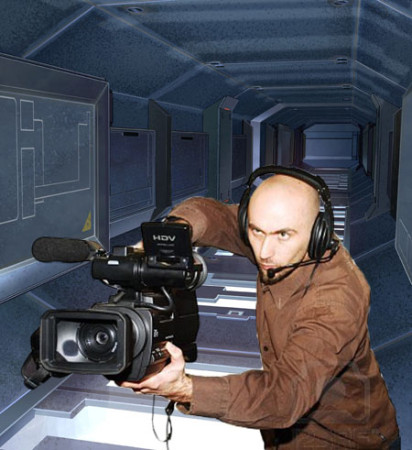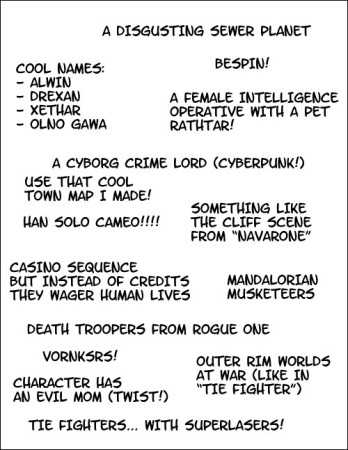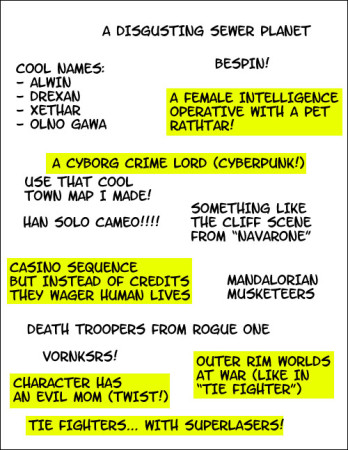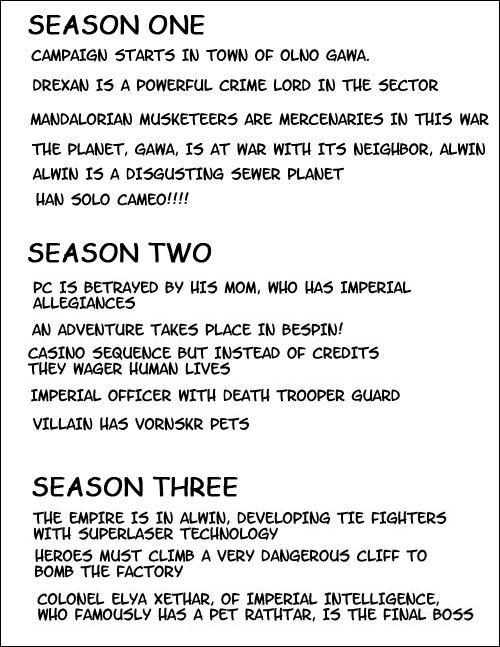
Hello and welcome again to The Force Does Not Throw Dice! Yes, yes: you probably forgot that this website had a series devoted to the Star Wars roleplaying game, but we are still here. It’s been a long time, but you know what they say: better late than fired!
Our previous campaign-building article on how to create your first campaign was rather popular, so I decided to start working on a few follow-ups. In this second article I’m going to be talking about how to structure your campaign using a template we all know quite well: that of a TV series.
Giving shape to your campaign is a daunting task, to put it mildly. Odds are that you will more or less know where you want to go with your game, but you won’t have the slightest idea of how you’ll go about it. I was the same until famed RPG designer Robin D. Laws wrote a piece called T.V. Structure in the pages of Dragon Magazine #293, a really good article where he talked for several pages about some of the typical tricks that television showrunners use in their craft and about how to implement them in your RPG campaign. Mr. Laws has written some extraordinary books about the art of game design that I regard as part of my personal GMing canon, but this one short article was probably one of the most influential RPG pieces I’ve ever read: even though campaign-building was just a small part of the piece, it completely changed the way I designed campaigns. Sure, as I’ve become my own GM with my own distinctive style, I’ve ended up dropping many of that article’s suggestions and reworking many others, but “TV series-style” is certainly still one of the main pillars of my campaign design philosophy.
There are many reasons to structure your campaign as a TV series. It’s very easy to add, remove or move around episodes, making your life considerably easier. The human brain loves patterns, after all, and TV has taught it many patterns that it knows well. And, after all, RPG campaigns are by their own nature already very similar to serialized fiction: a longer storyline arranged in discrete adventures or, at the very least, sessions.
So let’s start working on Star Wars RPG: The Series!
Introducing seasons to your game
If you followed the guidelines I offered last time, your campaign structure would be something like this: first, a few warming-up adventures; then, the stuff in between; and finally, an epic resolution. When we look at the whole campaign through the lens of a TV series, the warm-up adventures would be equivalent to the pilot episode, and the epic conclusion would be the final two-parter that concludes the story. This time we are going to focus on the meat, all that “stuff in between”, and try to give it some structure.
So how are we going to organize all that material in between? You could easily turn it into a full ongoing series of adventures where each one feeds into the next one, but if you choose this model you will find that momentum can be hard to maintain. Alternatively, you could split it into small story arcs, like comic books often do, and have each story arc follow the next one, but this can often feel too constrictive and allow players to see the wires behind the stage more than they’d like to.
The happy medium? A seasonal structure. Once I’ve developed an idea for a campaign and worked on my master list, I usually break it into three parts, and then spread them through the campaign. Think of it as a macro three-act-structure, or even a trilogy (Star Wars!). So let’s say that I had this master list:

That’s a start! First, let’s identify the most solid ideas, the ones that could easily become the foundation for any of the seasons. Go full Marie Kondo and pick the ones that give you the most joy:

We have identified the ideas we enjoy the most, or that we find more memorable or powerful, so let’s use them as touchstones to split the whole lot among three seasons. Watch for ideas that seem to play off each other and group them together, and then we can start giving the campaign some shape. Let’s work on these ideas and see how we can shape them into something resembling three storylines:

Congratulations: you now have a campaign. At least the outline of one: we still have to work harder on fleshing out and connecting this hodgepodge of plotlines and worldbuilding. We need to keep in mind that no season should be completely isolated. We need to create connections between all these events: we want to start teasing in Season One things that are going to happen in Seasons Two and Three, and we probably want characters and plots from the first season to resurface later on. As we start doing this, we will start seeing more connections to create. Let’s take a look at one of these ideas, that of Elya Xethar, who apparently has become our “final boss” for Season Three: it would be a good idea to introduce her in Season One as a mysterious stranger and then proceed to show her rise to major threat in Season Two, for example. If we do that with every single plotline that we feel merits the attention, we might end up with something like this:

And would you look at that! We have a storyline in three acts! Okay, this is not going to win us any awards, I know. I simply dumped some random stuff on this example master list. I didn’t really feel particularly strongly about any of it. But if I did…oh, this would be fire! And it would be the same for you.
Let’s take a closer look at Season One: after a couple of early adventures (the “pilot”), our heroes will be beginning their careers as do-gooders in Olno Gawa, the capital city of planet Gawa, an Outer Rim world currently at war with its neighbor, the noxious world of Alwin. Both planets are in the Outer Rim Territories; neither are part of the Empire. Our heroes have become aligned with the administration of Gawa: actually, one of the heroes’ mothers is the President of the Gawan Parliament! Soon, we will see our heroes working against the armies of Alwin, trying to settle the long war between both worlds. They will also fight against Drexan, a Gawan cyborg crime lord that’s profiteering from the conflict, and will have to fight against their equals in the Mandalorian Musketeers, a Mandalorian clan the Alwinians have hired. In the course of their adventures they will also meet Colonel Xethar, a treacherous Imperial spy that will show them that the Empire is Evil with a capital “E”. The huge Battle of Alwin will ultimately end the conflict with a decisive Gawan victory, but also with a shocking twist: the President of Gawa has been colluding with the Empire from the start, selling out both worlds and enabling the Imperial forces to take over the system. Betrayed, our heroes are forced to leave the system… but they declare that they will be back!
Look at that! We took a few ideas, we gave them shape, and we ended up with a campaign. So now, how do we go about turning this into adventures?
Adventures as episodes
One of the most valuable lessons I learned from Laws’ aforementioned piece is that most series use some particular episode types. Let’s see how that applies to an RPG campaign:
- Mythology episode: An adventure that advances the main storyline. These episodes bring the most serious changes to characters and world: main villains reappear, cities get destroyed, plots are twisted.
- Standalone: A self-conclusive adventure focused on the whole adventuring party, where all plot threads are concluded at the conclusion of the episode and most NPCs are never going to become regulars. Think of the “monster of the week” episodes from The X-Files-–a series that wore its structure on its sleeve—or think of a typical dungeon crawl in D&D.
- Character-focus episode: A type of standalone adventure that focuses on one or two of the main characters. This is the right time to use your players’ character backgrounds and write an adventure that touches on them. If the character background doesn’t have any particularly compelling plot hooks, you can still tailor an adventure to their preferences: the party’s gambler would probably love visiting Canto Bight, for example.
- Oddball episode: These adventures only show up once the player characters have become used to the tone of your campaign and you want to keep things from being too stale. Here you will take characters and players out of their zones of comfort and throw them into unexpected situations. Think of “Once More With Feeling” from Buffy or “Lysergic Acid Diethylamide” from Fringe. And what about beach episodes? Yes: beach episodes too.
Yes, some will call anything that it’s not a mythology adventure “filler”, but that’s inaccurate: character-focus episodes will move forward a given character’s personal story arc, standalones can still subtly foreshadow future developments, and oddball episodes…are often necessary for our sanity.

So how can we arrange these episodes? That depends on how you see your campaign. Do you want it to be mythology-heavy, or do you prefer to have a collection of standalones with some circumstantial connections between them? Both are completely valid approaches. If you want to have your cake and eat it too you can use the “half-arc structure”, that sets up the mythology in the first couple of adventures of the season and resolves it at the end, with the rest of the season being standalones with perhaps another mythology episode somewhere in the middle to push forward the greater storyline.
So let’s work a little bit more on our first season. Let’s imagine that we already have our players: Alan the Scoundrel, Beth the Force-User, Carlos the Pilot, and Danielle the Gambler. We’ve played a couple of random one-shots with them and now we are ready to drop them in the middle of our campaign.
1×01: “The Endless War” (mythology)
The PCs start working for Madam President of Gawa, who orders them to find and destroy an Alwinian terrorist cell before they blow up the planetary shields of Olno Gawa.
1×02: “Tremors in the Force” (character-focus)
Beth follows a vision that takes her and the PCs to the remains of the Gawa Jedi Temple. Why are Imperial soldiers in the ruins? And who’s the enigmatic Colonel Xethar and what are her designs for Gawa?
1×03: “Crime Does Pay” (standalone)
As a peace conference between Gawa and Alwin sounds more and more feasible, the PCs need to find out the origin of the recent attacks on Gawan ships. It turns out the cowardly crimelord Drexan is trying his best to make sure peace never comes to the system!
1×04: “Flying Solo” (character-focus)
Danielle is in trouble: she gambled the crew’s ship… and lost it to notorious smuggler Han Solo! The PCs are now forced to help Han and Chewbacca get some deadly cargo out of Alwin if they want their ship back before the President finds out!
1×05: “Mandalorian Hunt” (standalone)
The PCs are forced to fight the Mandalorian Musketeers, a group of Alwinian mercenaries that force them to play a deadly game in the jungle moon of Gawa.
1×06: “A Door Opens” (mythology)
The PCs are sent to infiltrate the criminal organization of Drexan, the self-proclaimed “Lord of Sins and Malady”, to obtain a very important piece of info: the secret codes to Alwin’s planetary shields.
1×07: “Slam Dunk” (oddball)
The secret offensive against Alwin is about to begin, but first, our heroes need to show their bravery in a different arena: that of basketball! Or aerohoop, the favorite sport in the system.
1×08: “Downfall” (mythology)
The final battle for Alwin, the end of the war, a heinous betrayal…and a new beginning.
And there we have it: an initial approach to your campaign. Why eight adventures? No real reason, to be frank. It’s a number that usually works for me. It’s too short to give everyone their own focus episode, but they will be getting them in the coming seasons, don’t worry.
Same Force-time, same Force-channel!
And that’s it for this time! As usual, let me say that this is just one way of doing things: maybe you’re a natural and you can write a campaign the way Stephen King writes books, just one word at a time. But even if that’s the case, I hope you’ve found some merit in this advice. See you next time!

This is great stuff. I’ve never GMed the Star Wars RPG–only ever participated as a player–but I’m currently a few sessions into GMing Call of Cthulhu for the first time, and it’s easy to see how this translates. it also offers some motivation to take the leap into a run at GMing Star Wars.
Bookmarking this page for future reference!